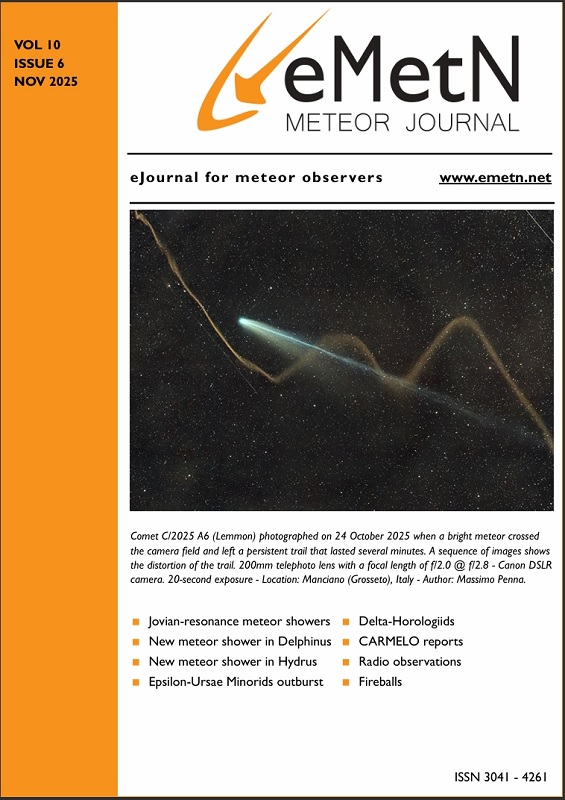One of the first meteors captured on the new camera 394 installed in Dourbes, Belgium, proved to be simultaneously with two other stations: Mechelen, Belgium (camera 390-391) and Oostkapelle, the Netherlands (camera 339). This meteor displayed a remarkable end flare of about magnitude –4.
(PDF version of this article).
Introduction
The CAMS@Benelux network started with two Watec cameras at two stations in March 2012. Four years later the network has 52 cameras at 18 stations. The network has the capacity to collect about 20.000 orbits per year and contributes to the main CAMS project (Jenniskens et al., 2011). More about CAMS@Benelux can be read in Roggemans et al. (2015).
Some results
Two new cameras, 394 and 395, were installed in Dourbes, near the Belgian-French border to operate within the CAMS@Benelux network. A missing connector prevented the 395 to start capturing meteors, but the 394 was successfully started. Although the pointing of the camera still needs to be adjusted, one of the first captured meteors appeared to be peculiar with an end flare. With the camera being pointed 17° too much north in azimuth compared to the calculated position, this meteor was captured in the field covered by the CAMS 390-391 (Mechelen, Belgium) and CAMS 339 (Oostkapelle, Netherlands).
Speaking about ‘beginners luck’, the new camera 394 captured this slow meteor nice in the center of the field of view. It is the kind of meteor trails we all hope to find each time that we confirm meteors and delete the false detections from our cameras. Figures 1 & 2 shows the images taken in Dourbes and Mechelen. The CAMS network coordinator, Carl Johannink, found this meteor back on data from 4 camera’s at 3 stations. The trajectory in height (km) and the light curve are plotted in Figure 3 & 4. For people not familiar with the CAMS program, it is important to know that within the CAMS network all 52 cameras are pointed at some calculated aiming points in order to optimize the overlap of the rather small FOV
(30° x 22°).

Figure 1 – The meteor of 2016-02-29 22:13:43.44 UT captured by CAMS 394 (Dourbes, Belgium).
Figure 2 – The meteor of 2016-02-29 22:13:43.44 UT captured by CAMS 391 (Mechelen, Belgium). (Photo : Luc Gobin).

Figure 3 – The meteor of 2016-02-29 22:13:43.44 UT the height of the atmospheric trajectory.

Figure 4 – The meteor of 2016-02-29 22:13:43.44 UT the light curves as registered by the different cameras.
Table 1 – Radiant and orbital elements computed by Carl Johannink for the meteor 2016-02-29 22:13:43.44 UT captured by CAMS 339 (Oostkapelle, the Netherlands), 390–391 (Mechelen, Belgium) and 394 (Dourbes, Belgium).
| CAMS Coincidence | |
| Radiant R.A. (°) | 149,0 ± 0,1 |
| Declination (°) | +33,6 ± 0,8 |
| Vg (km/s) | 16,38 ± 0,16 |
| Semi-major axis a (AU) | 3,001 |
| Perihelion distance q (AU) | 0,83622 ± 0,00328 |
| Inclination i (o) | 8,786 ± 0,311 |
| Eccentricity e (-) | 0,7214 ± 0,0089 |
| Argument of perihelion ω (°) | 231,125 ± 0,594 |
| Ascending node Ω (°) | 340,5427 ± 0,0020 |
References
Jenniskens P., Gural P. S., Dynneson L., Grigsby B. J., Newman K. E., Borden M., Koop M., and Holman D. (2011). “CAMS: Cameras for Allsky Meteor Surveillance to establish minor meteor showers”. Icarus, 216, 40–61.
Roggemans P., Johannink C., and Breukers M. (2015). “Status of the CAMS-BeNeLux network”. In Rault J.-L., and Roggemans P., editors, Proceedings of the International Meteor Conference, Mistelbach, Austria, 27–30 August 2015. IMO, pages 41–50.







Hi Paul. The meteor was so beautiful. Do you have the video? May I see? I’m from Brazil.
Congratulatios,
Jacqueline